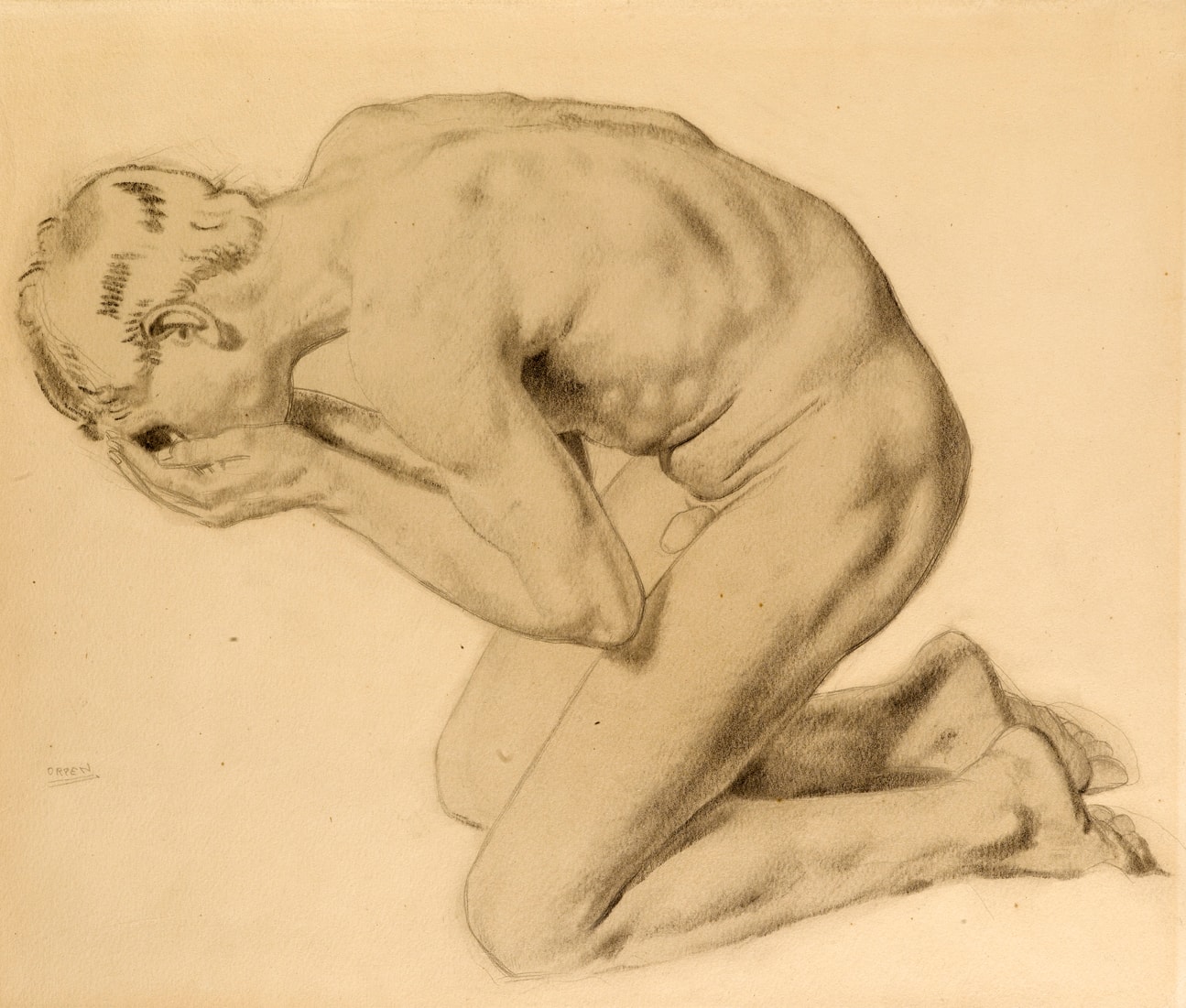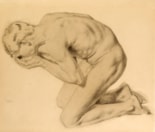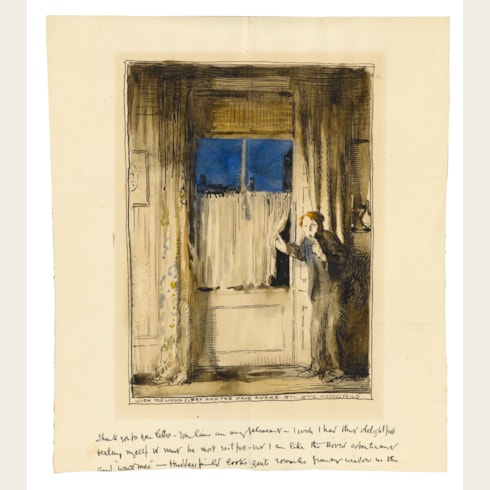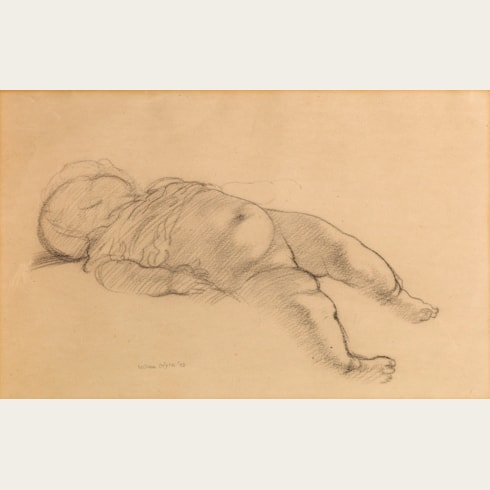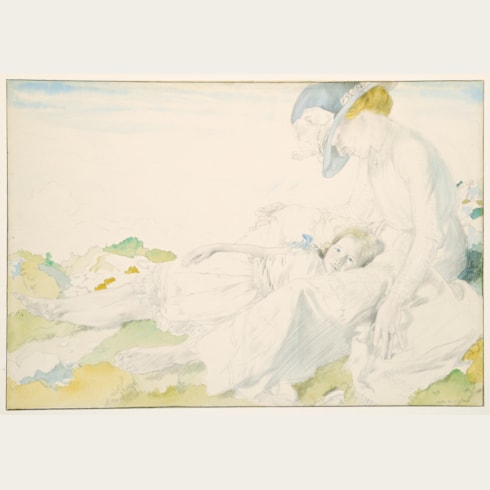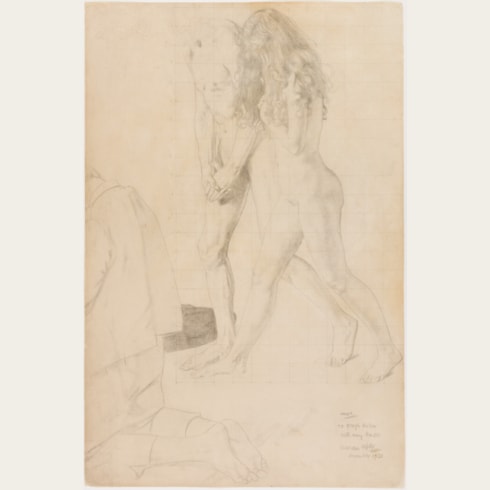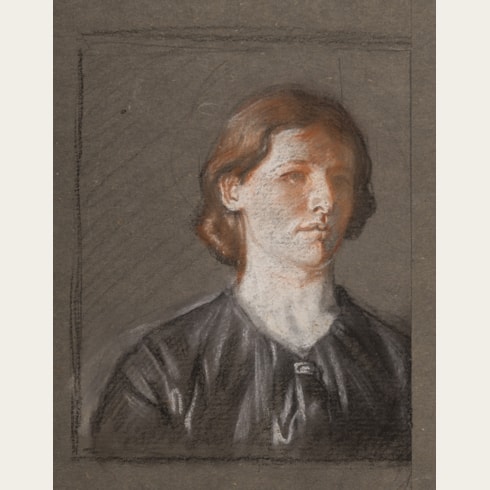William ORPEN
(Stillorgan 1878 - London 1931)
A Kneeling Man
Signed ORPEN at the lower left centre.
330 x 390 mm. (13 x 15 3/8 in.)
Orpen seems to have intended The Holy Well as a satirical allegory of the Celtic customs, morals and religious practices of his native Ireland, and the composition may have been inspired in part by John M. Synge’s play The Well of the Saints. A large painting, measuring over 8 1/2 by 7 feet, The Holy Well depicts the naked figures of the pagan Celtic people of ancient Ireland who, made to drink from a well, are thereby transformed into Christian Aran islanders.
Orpen devoted a considerable amount of time to making careful preparatory figure drawings for The Holy Well, both for individual figures and groups of figures. The present sheet is a particularly fine example of the artist’s draughtsmanship of this period. Orpen’s assistant Sean Keating recalled of The Holy Well that ‘The drawings from which he painted the figures were done in lead pencil on smooth white paper, the tones rubbed in with a paper stump. Orpen greatly admired Ingres’ drawings whom he rather resembled in looks but in my opinion they are finer than Ingres’, tho’ it is considered heresy to say so.’
Orpen’s painting of The Holy Well, together with a number of preparatory studies for it, was sold to the artist’s wealthy American patron and mistress, Florence Evelyn St. George, in 1916 for £2,000. It was hung, alongside the drawings, on the staircase of her London residence, Cam House in Kensington, where it was noticed by one art critic, writing in 1932: ‘Mrs. St. George owns, for instance, one of [Orpen’s] most important paintings – “The Holy Well” – and with it sixteen beautiful, nearly quarter life-size studies...’ The painting, together with its preparatory drawings, was lent by Mrs. St. George to the retrospective exhibition of Orpen’s work held at the Winter Exhibition at the Royal Academy in 1933. After her death, The Holy Well and its preparatory drawings, together with the rest of her collection and the contents of Cam House, were sold at two auctions in London in July 1939.
Orpen’s Studio book lists a number of preparatory drawings for the picture with names against them, suggesting that they may have been reserved for other buyers, but it is unclear whether they were in fact dispersed.
William Orpen showed a talent for art at an early age, and in 1891 was admitted into the Metropolitan School of Art in Dublin. He soon came to the attention of his teachers and contemporaries as an immensely gifted draughtsman, and won several prizes for his drawings. In 1898, he transferred to the Slade School of Art in London, where his drawings continued to impress all who saw them. At the Slade, where his professors included Philip Wilson Steer and Henry Tonks, he met and befriended Augustus John. The two young artists soon came to dominate their class at the school, where they were quickly recognized as head and shoulders above their fellow students in terms of talent. Orpen joined the New English Art Club, and exhibited at the Royal Academy and the Royal Hibernian Academy. He was appointed an Official War Artist in 1917, and his powerful paintings and drawings of the trenches in France were exhibited in London the following year. Knighted in 1918, Orpen later published more of his scenes of the war in An Onlooker in France, 1917-1919, which appeared in 1921. The 1920’s found the artist at the height of his success, firmly established as one of the leading portrait painters in England, with a fashionable clientele and no shortage of commissions. Yet after his death at the age of only fifty-two his reputation lapsed into obscurity, and it has not been until relatively recently that he has regained something of the stature he once enjoyed.
Throughout his career, William Orpen was admired as one of the finest draughtsmen of his day. He drew for long hours every day, and left behind a large corpus of drawings and sketches. As the critic of The Art News commented of a publication of a portfolio of ten photogravure reproductions of his drawings in 1915, ‘These drawings are remarkable not only for their delicacy of handling, but for the loving care with which the pencil has revelled in beauty of form. Mr. William Orpen is thoroughly modern, yet he continues a tradition which has been handed down from the great draughtsmen of the past. His work does not suffer when placed by the side of the work of the Old Masters, a supreme but dangerous test.’
Another critic, writing at the same time in The Ladies’ Field, noted that ‘Mr. Orpen may be described as a tender draughtsman, tender in his care of and love for his materials. His hand is so marvellously delicate. His pencil hovers over the paper with the grace of a butterfly…He does not strive for the beauty of feature, as the French draughtsmen of the eighteenth century tried to capture those qualities. At times he is almost ugly and brutal; but he never loses the beauty of form.’
Provenance
Exhibition

